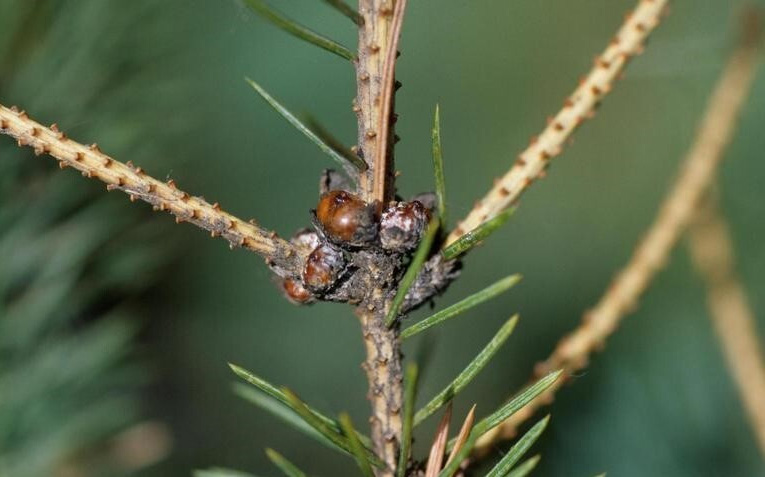Spruce Bud Scale (Physokermes spp.)

Figure 1. Spruce bud scale at the base of the needles. Photo by S. Katovich, Bugwood.
Host
Spruce trees.
Damage and Symptoms
The reddish-brown covering surrounding the scale resembles a spruce bud. Because of this, they are often unrecognized. The scale releases copious amounts of honeydew that can attract black sooty mold. Heavy infestations can cause dieback of lower branches.
Life Cycle
The scale nymphs spend the winter on the spruce needles or bud scales. In late spring, mating occurs followed by egg laying. Egg hatch occurs in June-July. The crawlers migrate to the needles to start feeding and then move to the twigs later in the spring. There is one generation per year.
Management
Provide spruce trees with adequate water. Dormant oils applied in early spring followed by a contact insecticide in late June (during the crawler stage) are recommended for management. Horticultural oils and some other oils can cause discoloration of the spruce needles. A systemic insecticide with the active ingredients imidacloprid or dinotefuran can be applied in the spring.
Further Information
To learn more about the topics discussed on this page, contact the Schutter Diagnostic Lab. If you suspect an infestation on your property, contact your local extension agent, the Schutter Diagnostic Lab at Montana State University, or the Montana Department of Agriculture.
This fact sheet is also available as a printable PDF (157KB).
Disclaimer: These recommendations are provided only as a guide. It is always the pesticide applicator’s responsibility, by law, to read and follow all current label directions for the specific pesticide being used. The authors and Montana State University assume no liability resulting from the use of these recommendations. The Montana State University Extension Service is an ADA/ EO/AA/Veteran’s Preference Employer and Provider of Educational Outreach.
